
Huller (centre) and moisture meters (bottom)
Currently, Lao has around 35,000 hectares of coffee - 88% of Robusta and 12% Arabica. Most coffee at this stage is produced by the 23,000 smallholder families located on the Bolovens Plateaux of southern Lao. Some larger Arabica plantings comprising some 400 to 500 ha will be coming into full production in the next two to three years. The Government of Lao is encouraging the planting of higher quality Arabica coffee at higher altitudes of above 1000 m.a.s.l., with a view to moving to a 50:50 Arabica:Robusta mix.
Current production per year is approximately 750 tonnes for Arabica comprising 500 tonnes from a large plantation (Dau Heuang) and 250 tonnes from smaller landholders; included in this is 80 tonnes of Typica. Exports for Robusta are approximately 14,000 tonnes from a production of about 15,000 tonnes per year. To date, most smallholders typically process Robusta coffee as dried cherry coffee (Natural method - sun drying of the fresh cherry). At sale, the coffee is roughly hulled by modified rice hullers, usually by a contractor, with the result being a relatively poor quality green bean product. Larger operations for Robusta have more professional hulling, cleaning and grading facilities.
Some Arabica is processed as natural dried cherry, and some is wet-processed using a full-wash, to produce parchment which is hulled to give green bean prior to sale. Fair Trade coffee buyers, including OXFAM and J'hai Foundation, assist this wet-processing with farmer groups. However, apart from this assistance, most Arabica coffee is currently poorly processed and the resultant quality is often poor.
Part of the focus of this FAO Coffee Project has been to emphasise coffee quality improvement via good harvesting, handling and new processing practices. Photographs of some equipment supplied by FAO are shown in sidebars and previous pages). In addition, the Project sent a range of Arabica and Catimor green beans from various altitudes for assessment by international buyers and local buyers/roasters. The coffee samples were collected as ripe cherry from farmers and processed at CREC using a standard full-wash wet process. Samples selected for assessment by buyers/roasters were first assessed by the FAO project International Consultants and CREC staff.
CREC now has a fully equipped coffee laboratory for tasting and physical assessment of green bean samples, including hullers, a Probat sample roaster and 2 kg/hr DiScaf roaster, Santos grinder, drying ovens, pH meter, expresso machine as well as a fully equipped wet processing area for Arabica and Robusta pulping, pulping/demucilaging and splitting/mashing of Robusta cherry as well as a small huller and small coffee storage warehouse. The Project also supplied the large concrete drying area and fully equipped weather station. Staff members at CREC have been thoroughly trained in cupping and natural, full-wash and semi-wash processing methodologies by project specialists.
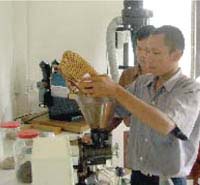
Grinding a coffee sample
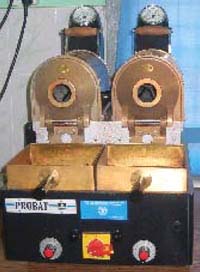
Sample roaster
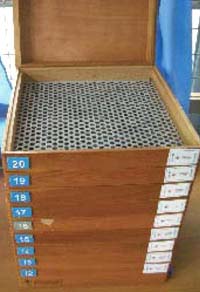
Sample grading screens
In an effort to standardize the process of evaluating the cup quality of coffee samples, the Project chose to use the quality evaluation process described in the Coffee Cuppers Handbook by Ted Lingle (Third edition, 2001) and published by the Specialty Coffee Association of America (SCAA).
The SCAA approach is a systematic, sensory evaluation process of a coffee. The process is divided into five evaluation steps with each step scoring from 1 to 10 points. A sixth step is added to give the coffee a Cupper's Point or Balance score from -5 to + 5. For convenience, 50 points is then added to the resulting score to give a score out of one hundred.
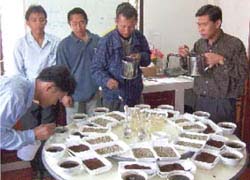
Tasting, evaluatung coffee
Six step SCAA evaluation process
| |
Step |
Ranking on |
Rating |
Scale range |
|
1 |
Fragrance of the ground coffee + |
Preference |
1 to 10 |
very poor to outstanding |
|
2 |
Acidity of the liquor |
Intensity |
1 to 10 |
very flat to very bright |
|
3 |
Flavour of the liquor |
Preference |
1 to 10 |
very poor to very bright |
|
4 |
Body of liquor |
Intensity |
1 to 10 |
thin to heavy |
|
5 |
Aftertaste of the liquor |
Preference |
1 to 10 |
very poor to outstanding |
|
6 |
Cuppers Points or Balance |
Taster's overall |
-5 to +5 |
very poor to outstanding |

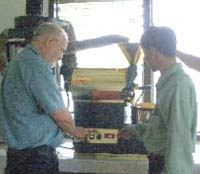
Commercial roasting of coffee at CREC
As a guideline, this SCAA scoring system should correlate to the SCAA Green Coffee Classification Chart where:
Class 1 Specialty Grade should receive 90 to 100+ points
Class 2 Premium Grade should receive 80 to 89 points
Class 3 Exchange Grade should receive 70 to 79 points
Class 4 Below Standard Grade should receive 60 to 69 points
Class 5 Off Grade should receive 50 to 59 points
The 12 samples used in the assessment were:
|
Sample 1 |
Catimor from Dau Heuang |
1083 m |
|
Sample 2 |
Catimor from Intha Group |
1065 m |
|
Sample 3 |
Catimor from Nongkali village |
1240 m |
|
Sample 4 |
Catimor from Thongset village |
1225 m |
|
Sample 5 |
Catimor from Kataut village |
1175 m |
|
Sample 6 |
Catimor from Being village |
1245 m |
|
Sample 7 |
Caturra from Phoumon village |
960 m |
|
Sample 8 |
Catimor from Thong Katai village |
1205 m |
|
Sample 9 |
Java from Intha Group |
1063 m |
|
Sample 10 |
Typica from Thong Set village |
1225 m |
|
Sample 11 |
Typica from Being village |
1200 m |
|
Sample 12 |
Typica from Katuat village |
1175 m |
After the initial assessment, the following seven best coffees were selected for blind tasting by commercial coffee buyers.
|
A Sample 1 |
Catimor from Dau Heuang |
1083 m |
|
B Sample 5 |
Catimor from Kataut village |
1175 m |
|
C Sample 8 |
Catimor from Thong Katai village |
1205 m |
|
D Sample 11 |
Typica from Being village |
1200 m |
|
E Sample 10 |
Typica from Thong Set village |
1225 m |
|
F Sample 12 |
Typica from Katuat village |
1175 m |
|
G Sample 9 |
Java from Intha group |
1063 m |
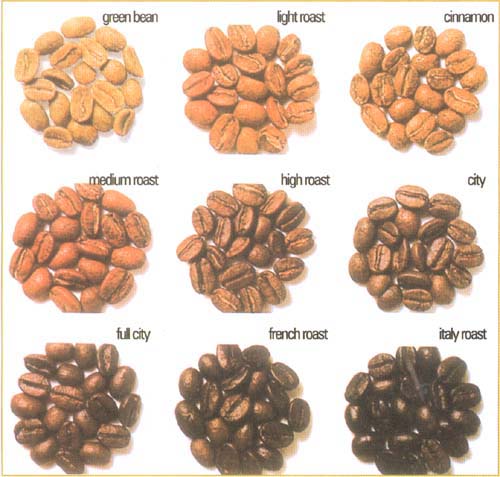
Coffee roasting chart
|
General comments on Arabica
|
Coffee evaluations by International buyers and assessors
|
Sample, Variety Location & Altitude |
Lao Mountain Coffee |
Ecom |
Holland Coffee |
CAFECONTROL Viet Nam |
Illy Café assessed as expresso coffee |
|
A |
80/100 |
60.2/100 |
Acidity: low |
Flavour: grassy |
Very good aroma, little defect in the beans |
|
B |
78/100 |
74.8/100 |
Acidity: low |
Flavour: medium |
Good taste, no significant defective beans |
|
C |
88/100 |
74.4/100 |
Acidity: low |
Flavour: medium |
Good taste, no significant defective beans |
|
D |
81/100 |
63/100 |
Acidity: low/medium |
Flavour: good |
Good coffee, similar to 'A' but less aroma |
|
E |
83/100 |
63.6/100 |
Acidity: low |
Flavour: slight good |
No defects, no particular body |
|
F |
72/100 |
73.4/100 |
Acidity: low |
Flavour: slight good |
Unfortunately green. Probably fresher than other coffees |
|
G |
88/100 |
71.6/100 |
Acidity: low/medium |
Flavour: good |
Woody taste |
|
General comments on Robusta
|